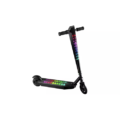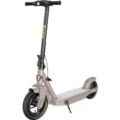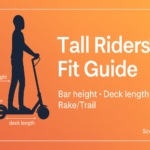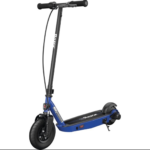- Home
- Scooters
- Electric Scooters
- Razor C45
Razor C45
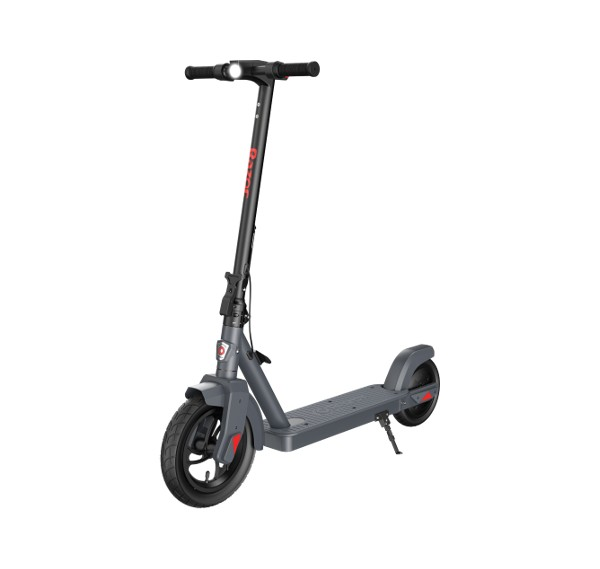

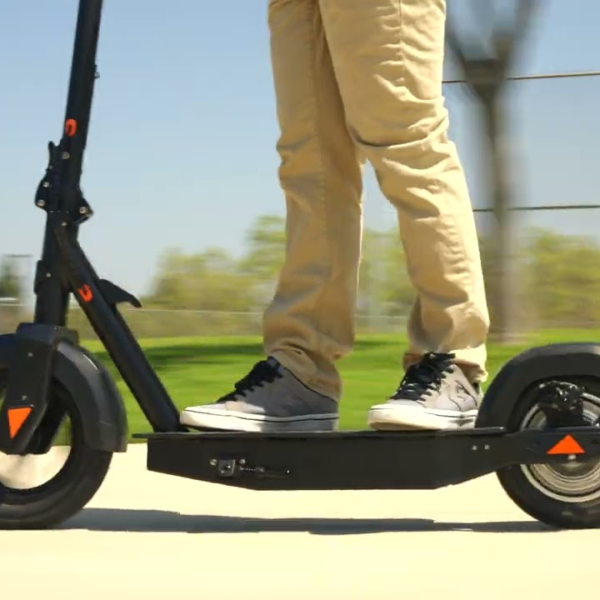
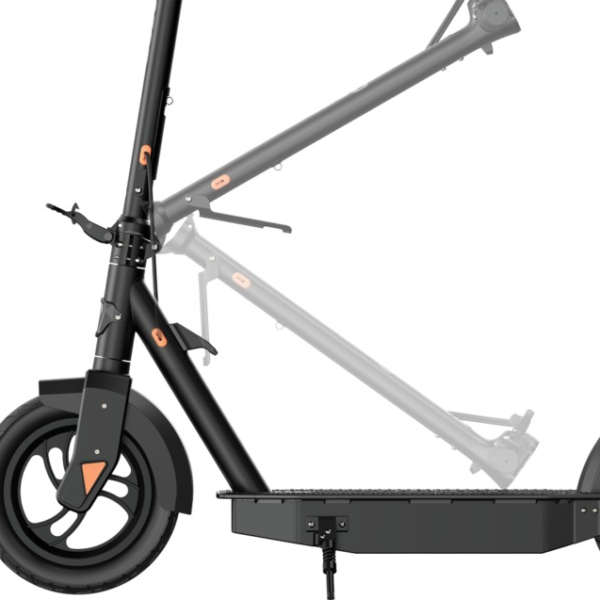
- Battery Range: 18 mi (29 km)
- Top Speed: 18 mph (29 km/h)
- Motor Power: 450 W nominal
- Weight Capacity: 220 lb (100 kg)
- Charging Time: ~6–7 h
- Scooter Weight: 31.5 lb (14.3 kg)
PROS
- Punchier 450W motor
- Quick fold and tidy footprint
- Predictable e-assist braking
- Bright lighting and reflectors
- Great balance of pace and control
CONS
- Firm ride on rough brick
- Range varies with hills/speed
- No full suspension
- App-free controls only

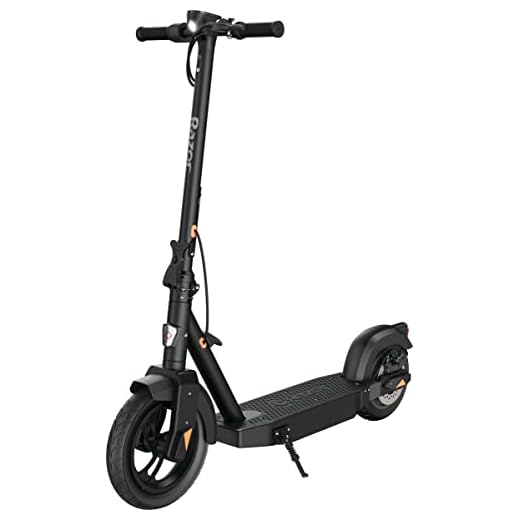
Table of contents
- What Is the Razor C45?
- How the Razor C45 Works
- Key Specifications
- Design & Build Quality
- Performance Fundamentals
- Battery, Range & Efficiency
- Ride Quality & Comfort
- Braking & Safety Features
- Portability & Daily Usability
- Maintenance & Care
- Weather & Seasonal Considerations
- Razor C45 vs Alternatives
- Who the Razor C45 Is (and Isn’t) For
- FAQs
- Glossary
- Closing Thoughts
The Razor C45 is a compact, adult-friendly electric kick scooter built for real-world city miles. It balances approachability with enough zip to make short trips feel easy. As a result, new riders appreciate its predictable handling, while returning riders value its practical build and low-drama upkeep. If you want a straightforward commuter that favors comfort and control over flash, this model fits neatly into daily routines.
What Is the Razor C45?
The Razor C45 is a single-motor, folding electric scooter designed for city streets and shared paths. Instead of chasing headline numbers, it prioritizes day-to-day usefulness. Consequently, the layout follows a proven blueprint: a hub motor in one wheel, a lithium-ion battery in the deck, and a foldable stem for storage or multi-modal travel.
Because the scooter focuses on composure, it highlights stability at neighborhood speeds, clear cockpit controls, and a deck large enough for an adult stance. In practice, many riders view it as a reliable “daily driver” rather than a weekend-only toy. Therefore, it suits commuters, students, and anyone who values predictable manners, steady braking, and a carrying weight you can live with.
How the Razor C45 Works
At first glance, an e-scooter can seem like a puzzle of housings and wires. However, the C45 is a clean, cooperative system with five core parts working together.
Motor. The hub motor is built directly into a wheel, so it sends push on command without chains or belts. As a result, there’s less to adjust and fewer parts to maintain. Because it lives in the wheel, it feels quiet, compact, and consistent when you roll on the throttle.
Controller. The controller acts like a careful driving instructor. It listens to the throttle, monitors the battery, and meters power to the motor. Consequently, you experience smooth starts, sensible power ramps, and calm responses over bumps or during quick inputs.
Battery. The lithium-ion battery rests in the deck. Inside the pack, a battery management system (BMS) balances cells, protects against over-charge and over-discharge, and manages thermal limits. Therefore, if you follow good charging habits, you’ll help the pack preserve health across seasons.
Throttle. Your right thumb (or index finger) sends a request to the controller. Ease in, and the scooter rolls forward gently. Press harder, and it builds speed in a controlled arc. Consequently, the feel is intuitive rather than jerky.
Brakes. Braking hardware varies by trim, yet the general behavior is similar. Squeeze the lever and the scooter sheds speed with a firm, progressive feel. If your trim includes electronic assist or light regenerative braking, you’ll also feel subtle “engine braking” that helps manage speed on gentle declines.
Together, these parts create a closed loop: you ask for speed, the controller provides power, the motor turns it into forward motion, and the brakes bring it back under control. Meanwhile, because the components are integrated, most riders only need routine checks—tire health, brake feel, and fasteners.
Key Specifications
Below is a clean, high-level table of the C45’s key areas. It focuses on the practical details riders evaluate every day. The word “specifications” appears here in a general sense—details can vary by region or trim.
| Block | Item | Detail |
|---|---|---|
| General | Category | Adult commuter e-scooter |
| Drivetrain | Single rear-hub motor (trim-dependent placement in some regions) | |
| Frame | Metal stem with reinforced deck; folding design | |
| Tires | Commuter-size tires; composition may vary by trim (pneumatic, solid, or mixed) | |
| Performance & Power | Power delivery | Smooth, commuter-oriented tune for city speeds |
| Riding modes | Multiple modes for new and experienced riders | |
| Acceleration | Predictable launch with moderate pull from a stop | |
| Battery, Charging & Electrical | Battery | Lithium-ion pack with BMS protection |
| System voltage | 36-volt class (common for commuter scooters) | |
| Charging | Barrel-style charge port; standard household outlet | |
| Estimated charge time | Several hours from low to full, depending on pack size | |
| Build & Dimensions | Deck | Adult-length standing area with firm grip |
| Stem | Folds at the base; latch or hook for carry/parking convenience | |
| Unfolded size | City-friendly proportions for mixed-path use | |
| Folded dimensions | Compact, trunk-friendly footprint for multi-modal trips | |
| Weight | Carryable for one adult; manageable for stairs and short walks | |
| Safety & Control | Brakes | Mechanical system with possible electronic assist (trim-specific) |
| Lighting | Front white light, rear red light; side reflectors for visibility | |
| IP protection | Splash resistance appropriate for light rain; avoid heavy storms | |
| Features & Extras | Display | Speed, mode, and battery indicators in clear view |
| Cruise control | Available on select trims or enabled by long-press (trim-specific) | |
| Kickstand | Sturdy side stand for quick stops | |
| App integration | Varies by region; core functions are onboard | |
| Warranty & Compliance | Warranty | Limited manufacturer coverage; terms may vary |
| Charger | Safety-tested; use the supplied unit only | |
| Local rules | Observe local speed/helmet/lighting requirements |
Design & Build Quality
The Razor C45 aims for a durable, low-maintenance build that stands up to daily use. As you unfold it, the stem locks with a reassuring clunk. Because the hinge area features a defined latch motion—not a vague, flexible fold—the bar feels like a solid steering column rather than a wobbly mast.
The deck provides real estate for a natural, staggered stance. Importantly, the grip surface resists slipping in drizzle and wipes clean afterward. Meanwhile, the fenders sit close enough to catch spray without rubbing, and the kickstand deploys with a simple flick. Consequently, quick coffee stops or classroom drop-ins stay hassle-free.
Fit-and-finish is practical. Cables route with sensible strain relief. The stem clamp aligns cleanly, and the latch remains accessible even with gloves. At the cockpit, the display is readable in daylight, and the throttle falls under your thumb without awkward wrist angle. In addition, the brake lever has a firm pivot and a clear bite point, which helps beginners avoid over-braking mid-turn.
Performance Fundamentals
Acceleration feel. From a standstill, the C45 eases forward rather than lunging. Consequently, riders feel relaxed in crowded bike lanes. Press the throttle deeper and the scooter builds speed in a smooth arc. The mid-range pull emphasizes holding pace rather than winning sprints, which makes mixed-traffic cruising comfortable.
Cruising stability. Straight-line stability is the commuter test. Here, the C45 tracks well at neighborhood speeds. Because the stem feels composed rather than noodly, your micro-corrections stay small. Keep both hands light on the bars and your knees slightly flexed; the scooter then glides without drama on decent asphalt.
Hill-climb behavior (7–10% grades). On modest inclines, the C45 continues forward with a steady hum. Entering with momentum helps the scooter hold speed. On steeper pitches, expect a gradual drop in pace rather than an immediate stall. Lean forward to keep the front planted, and maintain a consistent throttle to avoid surging. Consequently, you climb with fewer line changes and less wobble.
Battery, Range & Efficiency
Rated vs real-world range. Lab ratings assume ideal conditions: mild temperatures, smooth paths, and a light rider at a steady pace. Real life adds wind, stops, starts, and hills. Therefore, your usable range depends on how and where you ride.
Rider weight. Heavier riders use more energy at a given speed. If you’re near the top of the rider weight limit, plan shorter legs between charges or choose an efficiency-oriented mode. Conversely, lighter riders can stretch distance at the same pace.
Terrain. Smooth pavement rewards efficiency. By contrast, rough chip-seal, broken concrete, and frequent climbs tax the motor. If your route includes hills or patches of poor surface, budget extra energy and consider a slightly lower cruise speed.
Temperature. Batteries prefer temperate days. Cold reduces output and usable capacity, while extreme heat stresses cells. Consequently, store the scooter indoors and let a cold-soaked battery warm to room temperature before charging.
Pace and starts. Higher sustained speed uses more energy. So do repeated hard launches. As a result, you can stretch range by easing off the throttle to a steady cruise and planning ahead to avoid last-second braking.
Charging best practices. Top up after rides rather than running to empty. Additionally, use the supplied charger and keep the charge port cap sealed between sessions. If you store the scooter for weeks, leave the battery around mid-charge and check it monthly.
Efficiency habits that work. Keep pneumatic tires in the recommended pressure range. If your trim uses solid tires, inspect for nicks and embedded debris. Meanwhile, spin the wheels by hand occasionally to feel for drag, and listen for rubbing that signals a simple adjustment.
Ride Quality & Comfort
Tires. Tire composition varies by trim. Pneumatic tires offer more compliance and grip on rough surfaces. Solid tires resist flats and reduce maintenance. Consequently, many commuters choose a mixed setup—pneumatic front for comfort, solid rear for puncture resistance. Whatever you ride, inspect tread and sidewalls regularly.
Suspension behavior. Some commuter scooters rely mainly on tire compliance; others add basic suspension. The C45 prioritizes a simple, robust setup over complex linkages. Therefore, it feels most comfortable on decent pavement and well-maintained paths. On broken concrete, slightly bending your knees acts as natural suspension and preserves control.
Ergonomics and stance. Bar height supports a relaxed elbow bend. That posture reduces fatigue and improves steering input. Meanwhile, the deck length supports staggered-foot stance, and the deck grip keeps shoes planted in the wet. If you ride with light gloves, you’ll also notice less pressure on your palms during longer runs.
Stem flex. Commuters often worry about steering-column wobble. On the C45, the hinge design and clamp interface aim for a tight lockup. Keep the latch clean and properly adjusted; as a result, the stem feels firm under braking and cornering, which builds confidence over time.
Braking & Safety Features
Brake type and feel. The lever produces steady deceleration with a clear ramp from light scrub to confident slow-down. If your trim includes electronic assistance, you’ll feel mild resistance as you roll off the throttle, which helps control speed on short declines. Because the mechanical hardware is straightforward, inspection and adjustment remain approachable.
Lights and visibility. A forward white light and rear red light support dusk and dawn visibility. Side reflectors add lateral awareness in cross-traffic. Even with built-in lights, ride with smooth lines and bright clothing when possible. Consequently, you become easier to interpret for drivers and cyclists.
Ingress protection. The C45 is splash resistant for light rain, not heavy storms or standing water. Water can compromise bearings and electronics over time. If you get caught in a shower, slow down, increase following distance, and dry the scooter afterward. Then, allow it to reach room temperature before charging.
Audible signals. A bell or electronic chime helps communicate in mixed-use paths. Use it early and gently. Together with predictable lines, a light ring tells others exactly what you intend.
Portability & Daily Usability
Weight and carry. The C45 aims for a carryable curb weight. You can lift it for a flight of stairs, though ramps remain nicer. For longer carries, use two hands and keep the deck close to your side. Consequently, your hips and lower back do more of the supporting.
Fold mechanism. The fold releases with a defined motion and secures with a latch or hook. Practice the sequence in your hallway a couple of times before commuting. Then, at the train door, the process feels automatic—an everyday convenience that saves time and stress.
Storage. The folded footprint fits under a desk, behind a café table, or in a car trunk. At home, a wall hook or floor stand keeps the deck off the hallway. Avoid damp basements and hot attics; electronics like the same conditions you do. Therefore, store it in a dry, room-temperature space.
Security habits. When you can, bring the scooter inside. If you must lock outside, wrap a hardened lock through robust deck cutouts or a frame section that resists prying. Additionally, keep the lock off the ground and remove accessories that attract attention.
Maintenance & Care
Tire care. For pneumatic tires, check pressure weekly. Under-inflation adds rolling drag and invites pinch flats; over-inflation reduces grip and comfort. For solid tires, inspect for cuts and embedded objects. Additionally, verify wheel fasteners are properly torqued.
Brake adjustment. Pads wear gradually. If you notice a longer lever pull before the brakes bite, adjust per the manual. Keep the rotor or drum clean. Avoid touching braking surfaces with oily fingers. Consequently, your stopping power remains consistent.
Fastener checks. Vibrations work on bolts. Put a small torque routine on your calendar: stem bolts, axle nuts, brake-mount hardware, and fender stays. A five-minute check prevents a long walk home. Meanwhile, a dab of thread-locker—where appropriate—can reduce re-loosening.
Firmware and display habits. If your trim supports updates or settings, note your preferred mode and regen level. Avoid extreme settings until you understand the feel. Over time, consistent settings build muscle memory and smoother control.
Simple schedule.
- Weekly: Tire check, brake-feel test, quick bolt check.
- Monthly: Thorough bolt torque, hinge inspection, brake adjustment, lighting test.
- Quarterly: Deep clean, cable inspection, deck fastener re-torque, battery state review.
Battery storage. For breaks longer than two weeks, store around mid-charge in a cool, dry room. Check monthly and top up if needed. Crucially, never leave the charger connected indefinitely.
Weather & Seasonal Considerations
Rain. Wet surfaces reduce grip and lengthen braking distance. Therefore, slow earlier, keep a straight line over painted stripes and metal grates, and avoid puddles with unknown depth. After the ride, dry the scooter with a towel and let it sit in a room-temperature area before charging.
Cold. Cold air thickens lubricants and reduces battery output. Expect less pep and reduced range. Layer up so you stay relaxed, because tense shoulders lead to twitchy steering. Additionally, warm the scooter indoors before plugging in.
Heat. High heat stresses batteries and tires. Park in the shade and avoid leaving the scooter in a closed car. After a long, hot climb, give the system a minute to cool before charging. Consequently, you protect both cells and rubber.
Wind. Headwinds tax the battery. Tuck in, reduce speed slightly, and stand with knees bent. Tailwinds feel great—resist the urge to over-speed downhill. Instead, maintain a steady pace and keep braking margins generous.
Traction choices. If you ride through variable seasons, consider tires with a street-oriented tread that sheds water. If your trim uses solid tires, maintain a smooth pace and avoid aggressive lean angles on wet days. Under all conditions, read surfaces early and ride predictably.
Razor C45 vs Alternatives
Electric scooters cluster into categories: casual commuters like the C45, punchier performance models, and off-road or trail-ready machines. Because needs differ, your best match depends on routes, terrain, and storage.
Where the C45 excels. In city traffic and on shared paths, the C45’s gentle acceleration and balanced chassis feel calm. It shines when you value reliability, clear controls, and a weight you can carry during a train transfer. If your route is mostly flat with the occasional short hill, you’ll appreciate its steady pace and low maintenance.
Versus lightweight “last-mile” scooters. Ultra-light scooters carry easier, but many feel nervous at speed and transmit more road chatter. By contrast, the C45’s planted stance and sturdier stem provide confidence for daily trips, especially on uneven pavement.
Versus performance scooters. Higher-powered machines climb faster and cruise quicker, yet they weigh more and demand more attention. The C45 takes the opposite route: a calmer ride, simpler care, and fewer compromises at the office door. Consequently, it’s easier to own if you prioritize portability.
Versus off-road/trail scooters. Big-tire, long-travel models smooth dirt paths, but they can be excessive for paved commutes. If your riding is 95% asphalt, the C45’s simplicity wins on storage, carry, and upkeep. Meanwhile, you can still explore light gravel at modest speeds.
A note on style-forward or classic models. Some scooters lean on bold graphics or trick-inspired silhouettes. Others focus on a more traditional, easygoing ride. If you prefer that laid-back, classic feel, the Razor E300 remains a familiar baseline, though it trades features for simple, proven operation. The C45, by comparison, aims for modern commuter balance with clearer controls and a sturdier chassis.
Who the Razor C45 Is (and Isn’t) For
Ideal for:
- Urban commuters who want predictable handling and clear controls.
- Students who value a compact fold and a deck that feels stable at neighborhood speed.
- Multi-modal travelers who need to carry on stairs, onto trains, or into rideshare trunks.
- New riders who prefer calm acceleration and a learning curve measured in minutes.
Not ideal for:
- Steep-hill commuters tackling sustained grades beyond the 7–10% range.
- Speed chasers who want sport acceleration or high cruising speeds.
- Trail riders who spend most time off-pavement and need heavy-duty suspension.
- Tinkerers chasing advanced app tuning or multi-motor setups.
Because these categories reflect use cases, you’ll choose more easily by mapping your routes and storage limits first. Then, the C45’s balanced character either aligns with your commute—or points you toward a different class.
FAQs
1) Is the Razor C45 good for beginners?
Yes. Its power delivery is smooth, the controls are intuitive, and the chassis feels planted at city speeds. Consequently, new riders adapt quickly.
2) How far can I ride on a charge?
Real-world range depends on rider weight, terrain, temperature, pace, and stops. Expect less range in cold weather and on hilly routes. However, gentle throttle, steady cruising, and proper tire care stretch distance.
3) Can I ride the Razor C45 in the rain?
It is splash resistant for light rain. Nevertheless, avoid heavy downpours, standing water, and post-storm debris. Slow earlier and allow extra braking distance on wet surfaces, then dry the scooter before charging.
4) Does the Razor C45 have cruise control?
Some trims include a cruise-control function or allow activation via a long-press after maintaining speed. Use it on clear stretches and cancel well before intersections. Consequently, you preserve reaction time.
5) What maintenance does it need?
Check tires weekly, verify brake bite monthly, and re-torque fasteners on a simple schedule. Also, keep the hinge clean and the charge port cap closed between sessions to reduce avoidable wear.
6) How does it handle hills?
On moderate 7–10% grades, it maintains forward progress with steady throttle. Enter hills with momentum and adopt a forward stance to keep the front planted. Therefore, you climb with less steering input and better balance.
7) Where can I find a concise Razor C45 overview?
You just read one. For quick reference, revisit the Key Specifications table and the Maintenance & Care checklist.
Glossary
Amp-hour (Ah). A measure of battery capacity. Higher Ah usually means more stored energy at the same voltage.
Watt-hour (Wh). Battery capacity measured as voltage times amp-hours. Consequently, it’s a better indicator of energy than Ah alone.
Controller. The scooter’s electronic brain that meters power from the battery to the motor based on your throttle input.
Hub motor. An electric motor integrated into the wheel hub, eliminating chains and belts for low maintenance.
Regen (regenerative braking). Motor-based deceleration that recovers a small amount of energy and reduces brake wear.
Stem flex. Side-to-side or fore-aft movement in the steering column. A tight hinge and proper clamp reduce it.
IP rating. Ingress Protection rating indicating resistance to dust and water. Commuter scooters often target splash resistance.
BMS (Battery Management System). Electronics that protect and balance battery cells during charge and discharge.
Riding modes. Preset power levels controlling acceleration and top speed to suit different conditions and rider experience.
Deck. The platform you stand on. Length and grip influence comfort and control.
Throttle. The control that requests power, usually a thumb lever on commuter scooters.
Drum/Disc brake. Mechanical systems that provide friction for slowing down. Drum is sealed; disc is exposed but modular.
Inflation pressure. The air pressure in pneumatic tires. Correct pressure improves grip, range, and comfort.
Fold mechanism. The hinge and latch that allow the stem to fold for storage and carry.
UL-listed charger. A charger tested for safety by a recognized lab. Therefore, the supplied unit is the right match.
Closing Thoughts
The Razor C45 focuses on what riders do most: start, stop, and cruise through real city environments. Accordingly, it favors a calmer character over raw spectacle, which is exactly why many owners ride it daily. Add measured handling, manageable weight, and straightforward care, and you get a scooter that fits your life rather than forcing life to fit the scooter.
If you want to make short commutes simple and predictable, the C45’s design choices make sense. Ride within your environment, keep up with basic maintenance, and the scooter will respond with a steady, low-stress routine.
Specifications
General
| Model The Model specifies the exact version or name of the scooter. It helps identify its unique design, features, and specifications within the manufacturer’s product line. Knowing the model makes it easier to compare options, find compatible accessories, or look up support information. | C45 |
| Brand The Brand identifies the manufacturer or company that designs and produces the scooter. A trusted brand is a sign of quality, reliability, and good customer support. Well-known brands often have higher standards for safety, performance, and after-sales service, giving you more confidence in your purchase. | Razor |
| Release Date The Release Date indicates when the scooter model was officially launched on the market. This helps you know how current the design, technology, and features are. A newer release date often means updated components, improved performance, and the latest safety or smart features. | 17 November 2025 |
| Recommended Age Recommended Age indicates the minimum age range that the scooter is designed for, based on safety, size, and ease of use. Following the recommended age helps ensure that riders can handle the scooter’s speed, weight, and controls comfortably and safely. Always check local laws and use protective gear, especially for younger riders. | Recommended 16+ |
Performance & Power
| Motor Power (Wattage) What it means: The motor power, measured in watts (W), shows how strong the scooter’s electric motor is. Why it matters: Higher wattage usually means better acceleration, more torque, and improved performance on hills or rough terrain. For example, a 250W motor is good for flat city roads and light riders, while a 500W or 1000W motor provides more power for faster speeds or climbing steep inclines. | 450 W nominal |
| Top Speed The Top Speed indicates the maximum speed that the scooter can reach under optimal conditions. It’s usually measured on level ground with a fully charged battery and an average rider weight. A higher top speed allows you to travel longer distances faster, but always ensure you ride within legal speed limits and your personal comfort zone for safety. | 18 mph (29 km/h) |
| Battery Capacity Battery Capacity refers to the total amount of energy the scooter’s battery can store, usually measured in ampere-hours (Ah) or watt-hours (Wh). A higher battery capacity means you can ride longer distances on a single charge, reducing the need for frequent recharging. Keep in mind that actual range can vary depending on rider weight, terrain, speed, and weather conditions. | 36 V 10 Ah |
| Estimated Range per Charge The Estimated Range per Charge indicates the average distance the scooter can travel on a single full battery charge. This range is calculated under optimal conditions, such as flat terrain, moderate speed, and average rider weight. Real-world range may vary depending on riding style, terrain, weather, and load. A longer range means fewer recharges and greater freedom for longer trips. | Up to 18 mi (29 km) |
| Hill Climb Ability Hill Climb Ability describes the maximum incline or slope that the scooter can handle while maintaining stable performance. It’s typically expressed as a percentage or in degrees. A higher hill climb rating means the scooter can tackle steeper hills without losing too much speed or power. Actual climbing performance may vary based on rider weight, battery charge, and terrain conditions. | Up to 18° grades |
| Drive System The Drive System refers to how power from the motor is delivered to the wheels. Electric scooters typically use either a hub motor (directly integrated into the wheel) or a chain/belt drive system. A high-quality drive system ensures smooth acceleration, efficient power transfer, and low maintenance. The choice of drive system affects performance, noise level, and overall ride experience. | Rear hub motor (RWD) |
Charging & Electrical
| Charging Time Charging Time indicates how long it takes to fully recharge the scooter’s battery from empty to 100% using the standard charger provided. Faster charging means less downtime and more time on the road. Actual charging time may vary slightly depending on battery capacity, charger output, and environmental conditions. | Approx. 6–7 hours |
| Battery Type Battery Type refers to the specific technology used in the scooter’s battery, which affects performance, lifespan, weight, and charging time. Most modern electric scooters use high-quality lithium-ion (Li-ion) batteries because they offer a good balance of energy density, durability, and low maintenance. A reliable battery type ensures consistent power delivery and longer riding ranges. | Li-ion with Smart BMS |
| Removable Battery A Removable Battery means the battery pack can be easily detached from the scooter for convenient charging and replacement. This feature allows you to charge the battery separately, swap it with a spare for extended range, or securely store it indoors in extreme weather. Removable batteries add flexibility and make it easier to keep your scooter powered up wherever you are. | No external fast charge |
| Regenerative Braking Regenerative Braking is an energy-saving feature that converts some of the energy normally lost during braking back into battery power. When you slow down or brake, the motor works in reverse to generate electricity, which helps extend the scooter’s range and improves overall efficiency. This system also reduces wear on traditional brake components, leading to lower maintenance over time. | Regenerative electronic assist |
| Lighting Lighting refers to the built-in front and rear lights that enhance visibility and safety when riding in low-light conditions or at night. Good lighting helps you see the road ahead and ensures that other road users can see you. Many scooters include LED headlights, taillights, and sometimes brake lights or side reflectors for added safety and compliance with local traffic regulations. | Headlight + tail/brake + reflectors |
Build & Dimensions
| Scooter Weight Scooter Weight refers to the total weight of the scooter when fully assembled, including the battery. This affects how easy it is to carry, lift, and store the scooter when not in use. A lighter scooter is more portable and convenient for commuting, especially if you need to carry it upstairs or onto public transport. Keep in mind that a sturdy frame and quality components may add to the weight but also contribute to better durability and ride stability. | 31.5 lb (14.3 kg) |
| Maximum Rider Weight Maximum Rider Weight indicates the highest rider weight that the scooter is designed to safely support while maintaining optimal performance and stability. Staying within this limit helps ensure reliable acceleration, braking, and climbing ability, and it protects the frame, suspension, and motor from excessive strain. Exceeding the recommended limit may reduce performance and increase wear on components. | 220 lb (100 kg) |
| Deck Size Deck Size refers to the dimensions of the scooter’s standing platform. A wider and longer deck provides more foot space, allowing you to stand comfortably and adjust your stance while riding. A well-sized deck improves balance and stability, especially on longer rides or at higher speeds. Compact decks, on the other hand, help keep the scooter lightweight and portable. | Low deck; neutral steering |
| Handlebar Height Handlebar Height refers to the distance from the deck to the handlebars, which affects your riding posture and comfort. An appropriate handlebar height helps you maintain good balance, reduces strain on your back and arms, and makes steering more comfortable. Some scooters have adjustable handlebars to fit riders of different heights, while others have a fixed height for a streamlined design. | Adult fixed bar height |
| Folding Mechanism The Folding Mechanism describes how easily and securely the scooter can be folded for carrying and storage. A well-designed folding system lets you quickly collapse the scooter into a compact size, making it convenient to transport on public transit, store under a desk, or fit into a car trunk. Look for sturdy latches and safety locks to ensure the scooter stays firmly in place when folded or unfolded. | Quick folding latch |
| Dimensions Folded Dimensions indicate the size of the scooter when it’s fully folded. This measurement shows how much space the scooter will take up when stored or carried, making it easier to check if it will fit in your car trunk, under a desk, or in a closet. Compact folded dimensions are ideal for commuters who need to bring their scooter on public transport or store it in tight spaces. | 45.2 × 18.6 × 19.8 in (folded) |
| Material Material refers to the primary construction materials used for the scooter’s frame and key components. High-quality materials like aircraft-grade aluminum, reinforced steel, or durable composites provide strength, stability, and a lighter overall weight. A sturdy material ensures the scooter can handle daily wear and tear while maintaining safety and performance. | Aluminum alloy |
Safety & Control
| Brake Type(s) Brake Type(s) describe the braking systems the scooter uses to help you slow down or stop safely. Common brake types include mechanical brakes (like drum or disc brakes), electronic brakes, and foot brakes. Many scooters combine multiple braking systems for added safety and shorter stopping distances. The type and quality of brakes affect your control, especially when riding at higher speeds or on slopes. | Front electronic + rear disc |
| Suspension Suspension refers to the system that absorbs shocks and vibrations while riding, providing a smoother and more comfortable ride over uneven or rough surfaces. Scooters may have front suspension, rear suspension, or dual suspension for better shock absorption and stability. Good suspension helps reduce rider fatigue and improves control, especially when riding on bumpy roads or off-road paths. | None |
| Tire Type Tire Type refers to the kind of tires the scooter uses, which directly affects ride comfort, traction, and maintenance. Common types include solid (airless) tires, pneumatic (air-filled) tires, or hybrid options. Pneumatic tires offer better shock absorption and a smoother ride on rough surfaces, while solid tires are puncture-proof and require less upkeep. The right tire type helps ensure safe handling and a comfortable ride in different conditions. | Honeycomb solid tires |
| Tire Size Tire Size indicates the diameter and width of the scooter’s tires, which affect ride comfort, stability, and how well the scooter handles different terrains. Larger tires generally offer better shock absorption and a smoother ride over bumps and rough surfaces, while smaller tires keep the scooter lighter and more portable. Choosing the right tire size helps ensure a balance between agility and comfort. | 10-inch |
| Kickstand The Kickstand is a built-in stand that allows you to park your scooter upright when it’s not in use. A sturdy kickstand keeps the scooter stable and prevents it from tipping over, protecting it from scratches and damage. It also makes storing and accessing your scooter more convenient, whether you’re at home, work, or on the go. | Side kickstand |
| Water Resistance Rating Water Resistance Rating indicates how well the scooter is protected against water and moisture, usually shown as an IP (Ingress Protection) rating. This rating helps you understand whether the scooter can handle light rain, splashes, or wet roads without damage. While most scooters are not fully waterproof, a good water resistance rating adds peace of mind when riding in changing weather conditions. Always avoid deep puddles or submerging the scooter to protect its electrical components. | IPX4 body |
Features & Extras
| Display/Console The Display (or Console) shows important real-time information about your ride, helping you monitor your scooter’s status at a glance. Typical displays show speed, battery level, distance traveled, and riding mode. Some models also include additional features like Bluetooth connectivity, app integration, or backlighting for better visibility at night. A clear and easy-to-read display enhances safety and convenience on every trip. | LED dashboard |
| Ride Modes Ride Modes refer to the different speed and power settings you can choose to match your riding style or road conditions. Common modes include eco for maximum range and energy efficiency, standard for everyday balance, and sport or turbo for higher speed and stronger acceleration. Switching between ride modes allows you to customize performance, conserve battery, and ride safely in various environments. | Eco, Drive, Sport |
| Smart App Connectivity Smart App Connectivity lets you pair your scooter with a dedicated mobile app via Bluetooth. Using the app, you can monitor real-time ride stats like speed, battery level, and range, adjust settings such as ride modes or cruise control, lock the scooter for added security, and sometimes receive firmware updates. This feature adds convenience and allows you to personalize your riding experience right from your smartphone. | App-free basic operation |
| Anti-Theft System The Anti-Theft System helps protect your scooter from unauthorized use or theft. This feature can include built-in alarms, electronic motor locks, GPS tracking, or remote locking through a mobile app. A good anti-theft system provides peace of mind when parking your scooter in public spaces, adding an extra layer of security to safeguard your investment. | N/A |
| Cruise Control Cruise Control allows you to maintain a steady speed without continuously holding the throttle. This feature makes longer rides more comfortable by reducing hand fatigue and providing a smoother, more relaxed riding experience — especially on flat, open roads or bike lanes. For safety, cruise control can usually be easily activated or deactivated while riding. | Yes (cruise control, region-dependent) |
| Accessories Included Accessories Included lists the additional items that come with the scooter to enhance your riding experience and convenience. Common accessories may include a charger, kickstand, bell, lights, phone holder, or carrying strap. These extras add value by making your scooter safer, easier to use, and ready to ride straight out of the box. | Bell, reflectors, charger |
Warranty & Compliance
| Warranty Period The Warranty Period indicates how long the manufacturer guarantees the scooter against defects in materials and workmanship under normal use. A good warranty provides peace of mind, showing the brand’s confidence in its product quality. Always check what parts are covered, such as the frame, battery, and motor, and follow the maintenance guidelines to keep your warranty valid. | 12 months typical (region-dependent) |
| Certifications Certifications confirm that the scooter meets specific safety, quality, and environmental standards set by recognized organizations or regulatory bodies. Common certifications may include CE, RoHS, UL, or other local compliance marks, depending on your region. These certifications ensure that the scooter is manufactured to high standards and is safe and legal to use in your country. | Local e-scooter compliance |
Price Comparison




